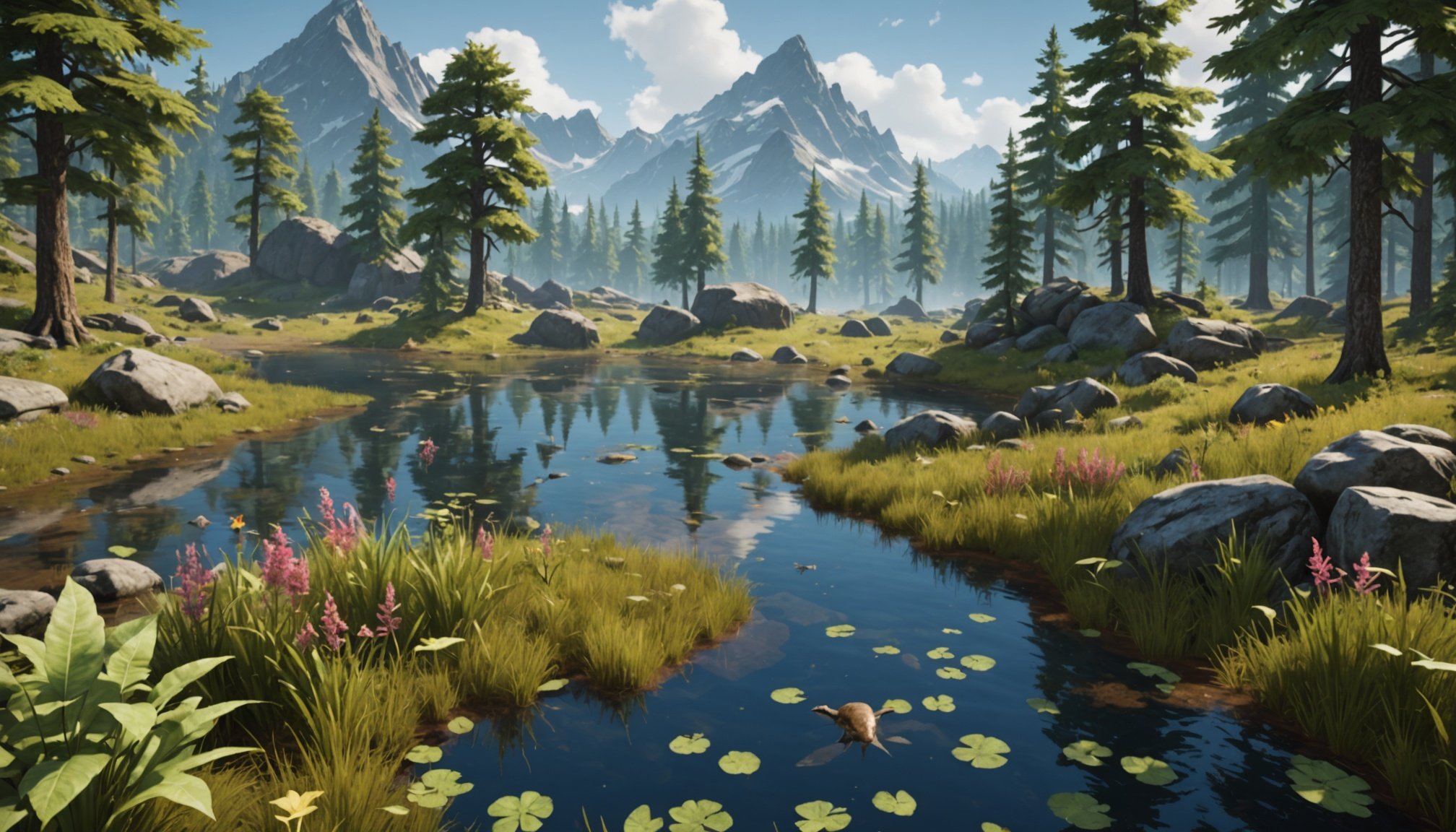Understanding Real-Time Biome Insights in Gaming
In the evolving landscape of game design, real-time biome data plays a pivotal role. As games seek to deliver more immersive and realistic experiences, the integration of dynamic ecosystems has become essential. This data allows game developers to simulate complex environments where players can witness the impact of their actions in a virtual world reflective of real-world ecosystems.
Ecosystem simulations are not just about visuals; they delve deeply into wildlife dynamics, fostering not only entertainment but also education. Players can observe authentic wildlife behavior, which adds depth to the gaming narrative. For example, a player might see how altering one aspect of the environment can lead to changes in species populations or behavior patterns. This level of detail appeals to gamers who appreciate authenticity and are eager to learn about environmental interactions.
Additional reading : Unveiling the challenges of voice-controlled interfaces in strategy games: a deep dive into integration obstacles
Moreover, the analysis and incorporation of wildlife behavior in games significantly enhance player engagement. When players understand the intricate interconnections of an ecosystem, the game becomes more than just a series of tasks. It transforms into an educational tool, where actions have tangible consequences. This encourages players to make informed decisions, thereby investing more emotionally in the gameplay and increasing overall satisfaction.
Examples of Games Utilizing Real-Time Biome Insights
Incorporating interactive gaming with real-time biome data has become a milestone in game design. Games that leverage such technology create unmatched experiences in wildlife simulations.
Also to see : Mastering realistic traffic generation in urban simulation games: proven strategies for authentic experiences
Highlighted Game Title 1
One exemplary game utilizes dynamic weather patterns and ecosystems. Players navigate challenges reflective of real-world ecological dynamics. The game’s interactive elements allow players to witness the cycling seasons and animal migrations in virtual landscapes.
Highlighted Game Title 2
Another standout title offers immersive wildlife simulations focused on endangered species conservation. Through gameplay, players engage in preserving habitats and learning about biodiversity. This educational aspect heightens the player’s environmental awareness while maintaining engaging gameplay.
Highlighted Game Title 3
A third game has pioneered the use of real-time data for plant growth and weather changes affecting the game’s flora and fauna. Players can manage virtual habitats, observing the effects of weather on ecosystems. Such intricate details enhance the realism and depth of interaction with the natural world.
Integrating real-time biome insights in interactive gaming not only enhances the graphics and realism but fosters profound ecological education. This intersection of technology and nature often receives positive player feedback, indicating strong engagement and satisfaction levels. The sophisticated interplay between ecological accuracy and captivating storytelling makes these games both instructive and entertaining.
Technical Guidance for Implementing Biome Data
Implementing real-time biome data in game development demands meticulous technical implementation. This involves selecting the right tools and technologies to ensure smooth data integration. Here’s what you need to consider:
Real-time biome data requires robust systems. Key technologies include APIs for data fetching, databases for secure storage, and languages like Python or JavaScript for real-time processing. These technologies are essential for crafting immersive experiences and maintaining performance.
Data integration begins with a precise collection procedure. Implement APIs that gather and relay data efficiently, ensuring seamless flow from source to game environment. Regular updates and data checks prevent delays or discrepancies. Focus on a step-by-step methodology:
- Initiate with comprehensive data collection.
- Develop algorithms for processing and transformation.
- Integrate using middleware, ensuring data paths are reliable.
Optimizing performance centres around minimising latency and managing resource load. Use caching and asynchronous operations to handle large data efficiently. Aim for a balance between user experience and system stability by consistently testing and refining the system.
By adhering to these best practices, developers can enhance the depth and user experience of games that incorporate biome data, creating dynamic and interactive worlds.
Immersive Experiences through Wildlife Dynamics
Immersive gameplay is greatly enhanced by the intricate dynamics of wildlife interaction. The role of dynamic wildlife behaviour in storytelling and gameplay cannot be understated. By observing how animals behave differently depending on the player experience and choices, a realistic and engaging game environment is created. For instance, predators stalking prey or birds chirping and flying away on player approach can significantly elevate immersion.
Foregrounding environmental art and audio is another technique for enhancing immersion. Creating detailed foliage, realistic water reflections, and subtle wind effects contributes to a believable world. When players interact with these elements, the illusion of a living, breathing world is more convincing. The ambient sound of rustling leaves or distant wildlife calls further immerses players in a sensory-rich environment.
Several case studies highlight successful uses of wildlife interaction. One notable example is in “The Witcher 3,” where wildlife dynamics contribute to the depth of its environments. In another example, “Red Dead Redemption 2” employs environmental art and audio to create an authentic world where animals react genuinely to player actions, vastly improving the player experience.
These carefully crafted elements ensure that players enjoy a seamless fusion of gameplay and narrative, enhancing their overall engagement.
Educational Benefits of Interactive Ecosystem Simulations
Interactive ecosystem simulations offer unique opportunities for educational gaming, seamlessly blending learning with entertainment. By immersing users in dynamic, virtual environments, these simulations can effectively enhance ecological awareness and foster a deeper understanding of conservation issues.
In educational settings, these simulations serve as invaluable tools for environmental education. Through realistic scenarios, users gain insight into ecological interactions, biodiversity, and the impact of human actions on ecosystems. This experiential learning promotes active engagement, motivating learners to explore complex topics and develop critical thinking skills.
Moreover, integrating such simulations into curricula can reinforce traditional teaching methods. These tools provide a hands-on approach, allowing students to experiment, make decisions, and observe the outcomes within a controlled environment. As a result, students can build a more holistic understanding of ecological principles and wildlife conservation.
Several successful programs illustrate the potential of educational gaming in raising ecological awareness. Notable examples include school initiatives using simulation games to teach students about habitat preservation and endangered species. These projects demonstrate how interactive tools can be both informative and engaging, capturing students’ interest while educating them on important environmental issues.
Visual and Interactive Elements in Biome Simulations
The importance of visual fidelity and interactive features in biome simulations cannot be overstated, especially when it comes to player retention. Game aesthetics combined with interactive visuals play a crucial role in keeping players engaged and invested in the gameplay. Sophisticated graphical details and animations create an immersive experience that captivates the audience and encourages them to explore further.
In recent years, there has been a showcase of innovative visual techniques utilized in gaming. Techniques such as dynamic lighting, real-time reflections, and procedural generation are pushing the boundaries of what is visually possible, enhancing the realism and depth of game environments. These advancements not only improve the overall aesthetic appeal but also offer new levels of interaction and engagement.
User interaction is elevated further through continuous user feedback, which plays a pivotal role in the evolution of interactive design. Developers actively seek and incorporate player input to refine game mechanics, adjust visual aesthetics, and introduce novel features that enhance the overall experience. This feedback loop ensures that games remain adaptive, relevant, and increasingly interactive. Thus, the fusion of interactive visuals and user-centric game aesthetics leads to a more dynamic and satisfying gaming experience for players.











